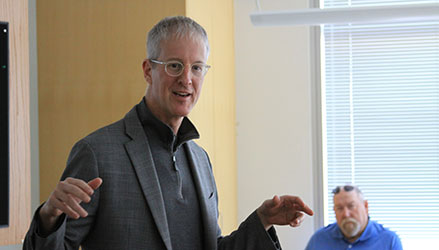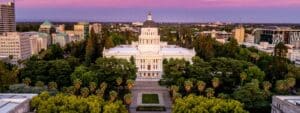
Renowned city planner, urban designer, and author Jeff Speck has dedicated his career to determining what makes cities thrive. And he has boiled it down to one key factor: walkability. His latest book, Walkable City: How Downtown Can Save America, One Step at a Time, was the best-selling urban planning and design title of 2013.
We agree that walkability is an essential component for creating thriving neighborhoods throughout the Bay Area.
On May 21, Greenbelt Alliance had the pleasure of hosting Jeff in the Bay Area and ask him some questions. Here are the highlights from our conversation with Jeff Speck:
Greenbelt Alliance: How can walkability help the Bay Area maintain and grow our economy, rather than fall behind?
Jeff Speck: Eighty-four percent of what you spend on driving leaves the local economy. Cities like Portland have demonstrated that investments in transit, biking, and walkability create considerable savings for citizens, and that money is spent locally.
But more importantly, talent will go where people can have the highest quality of life, and recent polls and studies (i.e. the Mercer Quality of Life Survey) show that walkability is a key aspect of the lifestyle that most people say they want.
GA: In a region with record-breaking housing costs, how can walkability be used as a tool to help ensure that people across the socio-economic spectrum can afford to live here?
JS: Housing is so expensive in walkable areas because of a supply and demand disconnect—making walkable housing more common will make it cheaper.
But if you look at the cost of living rather than just the cost of housing, you find that people in walkable areas can actually afford to spend more on housing than in sprawl. The average “working class” American now pays as much for transportation as for housing. Imagine the benefits of being able to lose one or two cars per household!
GA: In the Bay Area, the large majority of residents live outside of our big three cities (San Francisco, Oakland, and San Jose). How do you improve walkability in our suburban communities?
JS: In the suburbs, with the rare exception of some “new urban” communities, it is only our downtowns and main streets that have the potential to support walkability. In these places, I work with the governments and the development community to install a better balance of uses, and then remake streets so that pedestrians and cyclists feel safe using them.
The other big move, also underway in the Bay Area, is to create new mixed-use villages around transit stops. But let’s not kid ourselves: The majority of the American suburban landscape will remain unwalkable, and our resources are better directed to those places with good bones, which are poised to benefit from investments in urban quality.
GA: The Bay Area is often seen as a national model and an early adopter on a variety of issues. Where is the Bay Area leading the country in terms of walkability?
JS: San Francisco, Oakland, and Berkeley are seen as real leaders in just about everything, walkability included. Other parts of the Bay Area are remarkable for the innovation that they have spawned despite lacking an urban structure. In some ways, the success of Silicon Valley confounds the economic arguments in favor of urbanity—it makes it clear that urbanism is not a necessary prerequisite to innovation. But most of us who think about these issues believe that the Bay Area will be even more innovative as it becomes more urban.
GA: Which cities are beating us in walkability?
JS: Well, Portland beats just about everybody, and the big Canadian cities, especially Vancouver, are way, way ahead.
GA: What changes can we make to our communities that don’t cost a lot of time or money, but have a major impact?
JS: In almost every community, the low-hanging fruit is the simple re-striping of streets to take roadway that actually serves no purpose—lanes that exceed the number that the traffic volume demands, lanes that are wider than they should be, over-long and unnecessary turn lanes—and rededicate it to other uses, such as bike facilities or missing curb parking. I am doing this in four cities as we speak. You don’t need to invest more heavily. Paint is cheap, and changes more than you can imagine.




